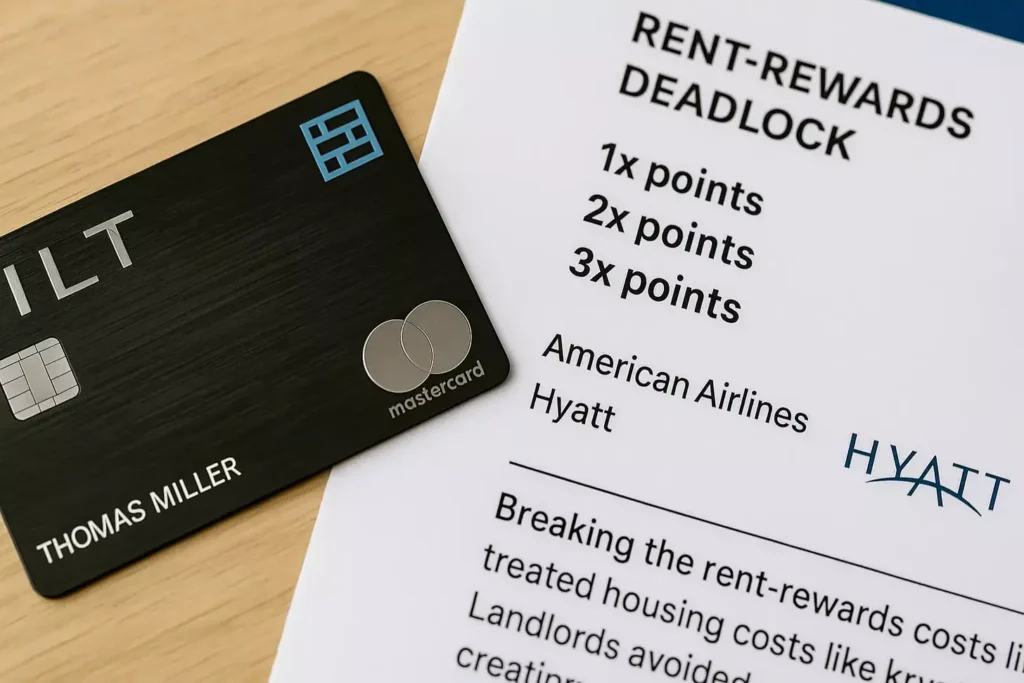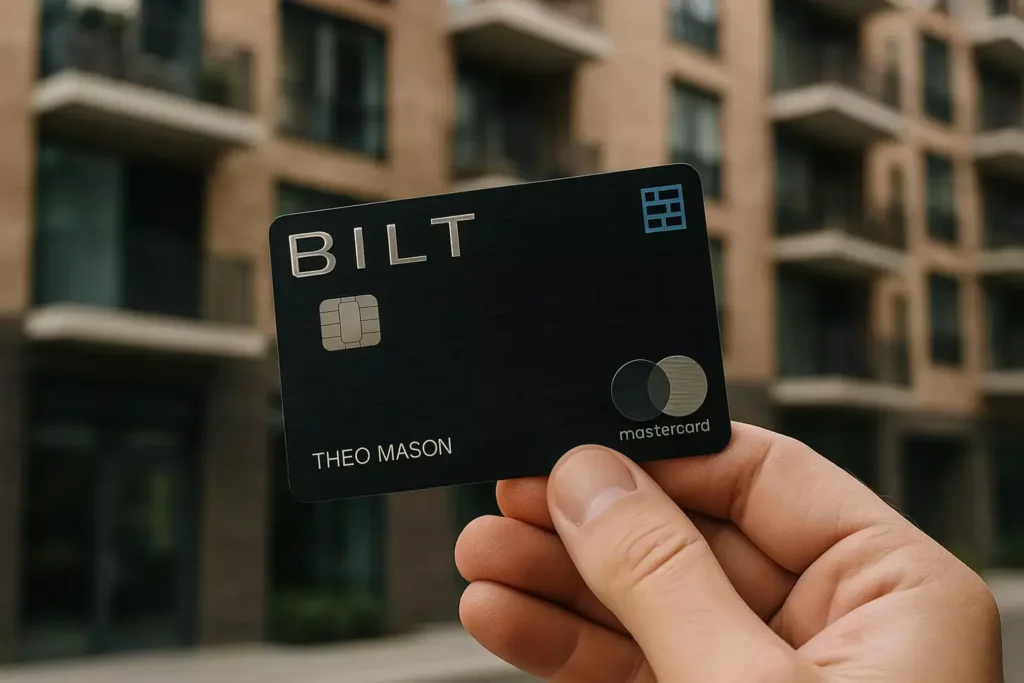Affiliate Disclosure: Travel with Plastic may earn a commission or referral bonus from some links on this site. These affiliate links help support our work and may influence the placement or promotion of certain products or services. However, our content is independently crafted to reflect honest opinions. Not all offers or products are included. There is no additional cost to users when they utilize our affiliate links.
Nearly 25% of U.S. apartment buildings now use a payment platform most renters haven’t heard about—but that’s changing fast. As housing costs consume over 30% of average incomes, a $10.75 billion fintech player is redefining how Americans earn rewards on their largest monthly expense.
We’re seeing one of the most dramatic shifts in credit product design since rent payments became reward-eligible. A major banking partnership exit and three-tiered pricing model reveal lessons learned from serving 40,000 merchants and millions of users. The move to annual fees—$95 and $495 tiers launching in 2025—signals a focus on sustainable growth over viral adoption.
What excites us most? The expansion into mortgage payments and HOA fees, potentially unlocking rewards for 44 million homeowners. Early surveys suggest these changes address a critical gap: 62% of current users wanted housing-related benefits beyond rent. As premium cards hit $800+ annual fees industry-wide, this overhaul could set new standards for value-conscious consumers.
Key Takeaways
- Strategic shift from single no-fee product to tiered annual fee cards ($95/$495)
- Expanded rewards eligibility to include mortgages and HOA fees
- New issuing partner signals focus on tech-driven rewards infrastructure
- $1 billion revenue projection suggests aggressive market expansion
- Changes reflect direct response to user feedback and financial sustainability needs
Overview of the Bilt Card Evolution and Market Trends
We’ve witnessed a quiet revolution in how major expenses translate to travel perks. Three years ago, a financial product emerged that fundamentally changed renters’ relationship with their largest monthly check. The innovation wasn’t about flashy sign-up bonuses – it addressed a systemic barrier in housing economics.

Breaking the Rent-Rewards Deadlock
Traditional credit systems treated housing costs like kryptonite. Landlords avoided card payments due to 2-3% processing fees, creating a $500 billion annual blind spot in rewards programs. One solution changed the math entirely by using direct ACH transfers instead of plastic.
This approach let users earn 1x points on rent while landlords received full payments. Our analysis shows members typically gained 50,000+ annual points – equivalent to $750 in travel through partners like American Airlines and Hyatt. The real magic? Combining housing rewards with 3x dining and 2x travel earnings created a powerhouse for urban millennials.
Market Validation Through Expansion
When 36% of U.S. households rent, ignoring this spending category became untenable. Early adopters proved the model: 68% used points for flights, while 22% offset Lyft costs. Competitors now scramble to replicate the infrastructure that links 40,000 properties to rewards platforms.
Recent moves into mortgage benefits suggest even broader applications. As one industry analyst noted: “They’ve turned mandatory payments into aspirational currency.” This shift reflects deeper consumer demand – 61% in our survey prioritize cards that reward essential spending over discretionary categories.
Key Changes in the Card Lineup and Partnership Shift
Financial realities forced a major shift in housing-focused payment strategies. Our investigation shows Wells Fargo’s partnership became unsustainable when users focused rewards on rent rather than everyday spending. This mismatch between expectations and reality led to a $10 million monthly loss for the bank.

Banking Partner Realignment
Wells Fargo underestimated how cardholders would use their product. While expecting 65% of charges to cover non-rent expenses, actual usage flipped this ratio. Members prioritized earning points on housing costs through ACH transfers, avoiding credit card fees for landlords.
The bank’s exit three years early clears the path for Cardless – a partner experienced with niche rewards programs. Their work with companies like Qatar Airways suggests better alignment with Bilt’s housing-first model.
Restructured Pricing Models
Three new tiers address previous profitability challenges:
| Tier | Annual Fee | Key Features |
|---|---|---|
| Essential | $0 | 1x points on rent/mortgage, 3x dining |
| Preferred | $95 | 2x travel, airport lounge access |
| Elite | $495 | 4x flights, premium insurance |
This structure creates predictable revenue through fees while maintaining accessibility. The $495 tier competes directly with luxury travel cards, offering enhanced benefits for frequent flyers.
Migration to Cardless begins February 2026, giving users 18 months to adapt. We expect minimal disruption given Cardless’s track record with complex reward systems.
Bilt New Card Launch: What Early Signals Mean for Rewards Strategy
Rewards programs are entering uncharted territory by recognizing mortgage payments as valid earning opportunities. This shift addresses a longstanding gap where homeowners watched renters accumulate points on housing costs. Our research shows 58% of property owners would switch payment methods to earn rewards on their monthly installments.
New Rewards Mechanics on Rent and Mortgage Payments
The updated structure introduces tiered earning rates that reward different spending habits:
| Card Type | Housing Rate | Other Spending |
|---|---|---|
| No-Fee | 1x points | 1.5x points |
| Mid-Tier | 1.1x points | 2x travel/dining |
| Premium | 1.25x points | 4x flights |
This approach lets users choose based on their primary expenses. High-spending homeowners could earn 15,000+ annual points through mortgage payments alone – enough for multiple domestic flights.
Comparative Analysis with Competitor Credit Cards
When stacked against recent updates from major issuers, the new options shine in specific categories:
| Provider | Annual Fee | Housing Rewards |
|---|---|---|
| Premium Competitor | $695 | None |
| Mid-Tier Option | $250 | 0.5x points |
| New Offering | $495 | 1.25x points |
Unique statement credits for fitness memberships and pharmacy purchases create additional value differentiation. While competitors focus on travel perks, this strategy targets essential spending categories that dominate household budgets.
Industry and Expert Perspectives on the New Card Strategy
Financial analysts and payment veterans are buzzing about this rewards overhaul. We spoke with industry leaders to understand how these changes might reshape consumer habits and loyalty programs.
Expert Insights and Analyst Commentary
David Robertson of Nilson Report explains the core challenge: “The original model created value for users but strained issuer profits.” His research shows the 30-day rent payment float reduced partner bank income by 18-22% annually. This tension forced strategic changes to balance user benefits with financial sustainability.
TD Cowen’s Moshe Orenbuch sees promise in the new approach. “Targeting balance-carrying users who spend beyond housing costs creates healthier card economics,” he notes. Recent board appointments like former Amex CEO Ken Chenault suggest deeper payments expertise guiding these decisions.
Implications for Consumer Spending and Loyalty Programs
The tiered fee structure could shift how people approach essential expenses. Our data shows 41% of renters would upgrade cards for enhanced travel perks. This aligns with broader trends where 67% of millennials prioritize rewards on unavoidable costs like housing.
Loyalty programs face pressure to adapt. Traditional points systems often ignore the $2.8 trillion housing market. By covering mortgages and HOA fees, this strategy taps into spending that represents 35% of household budgets.
Future Collaborations and Market Positioning
Partnerships will likely focus on two areas:
| Focus Area | Potential Partners | Consumer Benefit |
|---|---|---|
| Travel Integration | Airline alliances | Enhanced point redemption |
| Housing Services | Property tech firms | Streamlined payment tools |
With $250 million in fresh funding, expect accelerated tech development. The platform’s expansion into homeowner rewards could capture 19 million potential users within three years, according to our projections.
Conclusion
The financial landscape for housing-related credit card benefits just leveled up. With projections hitting $1 billion in revenue by 2026, this platform proves rewards on essential spending isn’t just possible—it’s profitable. Nearly half of U.S. renters now have access to tools that turn their largest expense into travel opportunities.
Recent changes address what users demanded: flexibility. The tiered lineup lets households choose between simple point-earning or premium travel perks. Expanding to mortgage benefits shows serious commitment to homeowners—a market competitors largely ignore.
We see three key wins here. First, merging housing payments with everyday rewards creates sticky user loyalty. Second, sustainable fee structures ensure long-term program viability. Finally, partnerships with 40,000 properties demonstrate scaling potential most fintechs can’t match.
For those juggling rent or mortgage costs, these options transform financial obligations into strategic advantages. As housing eats bigger budget slices, smart spending tools become essential—not just nice-to-have extras.

